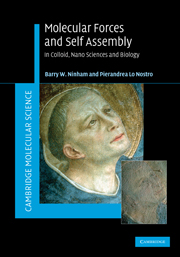Book contents
- Frontmatter
- Contents
- Preface
- Part I Molecular forces
- 1 Reasons for the enquiry
- 2 Different approaches to, and different kinds of, molecular forces
- 3 Electrostatic forces in electrolytes in outline
- 4 The balance of forces
- 5 Quantum mechanical forces in condensed media
- 6 The extension of the Lifshitz theory to include electrolytes and Hofmeister effects
- 7 Specific ion effects
- 8 Effects of dissolved gas and other solutes on hydrophobic interactions
- Part II Self assembly
- Index
- References
8 - Effects of dissolved gas and other solutes on hydrophobic interactions
from Part I - Molecular forces
Published online by Cambridge University Press: 06 January 2011
- Frontmatter
- Contents
- Preface
- Part I Molecular forces
- 1 Reasons for the enquiry
- 2 Different approaches to, and different kinds of, molecular forces
- 3 Electrostatic forces in electrolytes in outline
- 4 The balance of forces
- 5 Quantum mechanical forces in condensed media
- 6 The extension of the Lifshitz theory to include electrolytes and Hofmeister effects
- 7 Specific ion effects
- 8 Effects of dissolved gas and other solutes on hydrophobic interactions
- Part II Self assembly
- Index
- References
Summary
Bubble–bubble coalescence
Effect of electrolytes
The Hofmeister effects we have just discussed required a complete revision of theoretical ideas, and a revision of the way we interpret measurements that date back a century or more. We come now to some neglected phenomena that throw the entire theoretical applecart upside down again.
It is an extraordinary fact that an explanation of what appears the simplest conceivable experiment remains elusive. Breaking waves in the ocean are foamy, those in fresh water are not. Bubbles in salt water do not fuse, those in fresh water do. The experiment – illustrated in Figs. 8.1 and 8.2 – quantifies this effect, which is quite dramatic.
Bubbles of nitrogen pass through a glass frit, as in a fish tank, and ascend a column. As they do they collide and fuse, and the column stays clear. (There is no problem with impurities that might affect matters. The column is self-cleaning.)
If salt is added, nothing much occurs until around 0.1 M. Suddenly the bubbles do not fuse, they remain small and the column becomes a mass of small bubbles. The change can be monitored by a laser diode that measures transmission of light through the column, and the scale gives per cent coalescence vs. salt concentration. (The same experiments can be done with single bubble–bubble interactions.)
- Type
- Chapter
- Information
- Molecular Forces and Self AssemblyIn Colloid, Nano Sciences and Biology, pp. 232 - 250Publisher: Cambridge University PressPrint publication year: 2010



